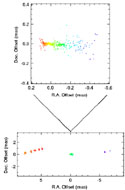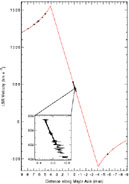


2.2 Kinematics of Radio Masers
A related approach exploits the few cases where 22 GHz microwave maser
emission from water molecules has been found in edge-on nuclear disks of gas.
Particularly strong ``megamasers'' allow radio astronomers to use
interferometry
to map the velocity field with exquisite angular resolution. In the most
dramatic application of this method, the Very Long Baseline Array was used to
achieve resolution 0".0006 - 100 times better than that delivered by
HST
- in observations of the Seyfert galaxy NGC 4258. This is only 6 Mpc away, so
the linear resolution was a remarkable 0.017 pc. The masers trace out a
slightly
warped annulus with an inner radius of 0.13 pc, an outer radius of 0.26 pc, and
a thickness of < 0.003 pc (Figure 4,
left). The masers with nearly
zero velocity with respect to the galaxy are on the near side of the disk along
the line of sight to the center, while the features with high negative
(approaching) and positive (receding) velocities come from the disk on either
side of the center. High velocities imply that 3.6 x 107
M of binding
matter resides interior to r = 0.13 pc. What is most compelling about
NGC 4258
is the observation that the rotation curve is so precisely Keplerian
(Figure 4,
right). From this result, one can show that the radius of the mass
distribution must be r
of binding
matter resides interior to r = 0.13 pc. What is most compelling about
NGC 4258
is the observation that the rotation curve is so precisely Keplerian
(Figure 4,
right). From this result, one can show that the radius of the mass
distribution must be r
 0.012 pc. If the central
mass were not a BH, its density would be extraordinarily high,
0.012 pc. If the central
mass were not a BH, its density would be extraordinarily high,
 > 5 x
1012
M
> 5 x
1012
M pc-3. This is comparable to the density of the dark mass at
the center of
our Galaxy (see following article). Under these extreme conditions, one can
show that a cluster of stellar remnants (white dwarf stars, neutron stars, and
stellar-size black holes) or substellar objects (planets and brown dwarfs) are
short-lived. Astrophysically, these are the most plausible alternatives to a
BH. Therefore the dynamical case for a supermassive black hole is stronger in
NGC 4258 and in our Galaxy than in any other object.
pc-3. This is comparable to the density of the dark mass at
the center of
our Galaxy (see following article). Under these extreme conditions, one can
show that a cluster of stellar remnants (white dwarf stars, neutron stars, and
stellar-size black holes) or substellar objects (planets and brown dwarfs) are
short-lived. Astrophysically, these are the most plausible alternatives to a
BH. Therefore the dynamical case for a supermassive black hole is stronger in
NGC 4258 and in our Galaxy than in any other object.

| 
|
Figure 4. (Left) Spatial distribution of the water masers in NGC 4258, color-coded so that blue and red correspond to blueshifted and redshifted velocities, respectively. The maser spots are distributed in a thin, warped annulus that is only 4° from edge-on. For an adopted distance of 6.4 Mpc, 1 mas = 0.031 pc. The top panel shows an expanded view of the emission near the systemic velocity of the galaxy. (Right) Light-of-sight velocity as a function of distance along the major axis of the annulus. The high-velocity features are accurately fitted by a Keplerian model, overplotted as a continuous line. The emission near the systemic velocity, magnified in the inset, lies at nearly constant radius in the front part of the disk along the line of sight to the center. The linear velocity gradient results from the change in projection of the rotation velocity. [Figure adapted from Miyoshi, M., et al. Nature 373, 127 (1995).] | |